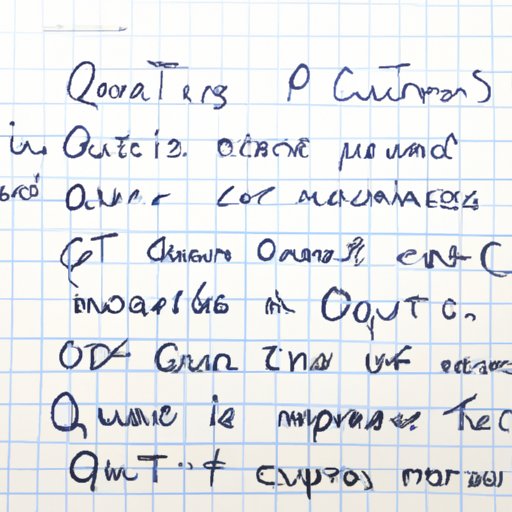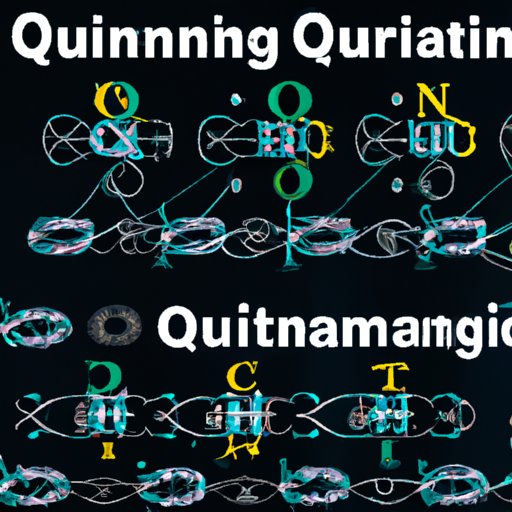Introduction
Quantum computing is an emerging field that promises to revolutionize computing technology by allowing us to solve problems that are too complex or time consuming for traditional computers. It relies on the principles of quantum mechanics to enable computers to process information at speeds far beyond what is currently possible. But what does a quantum computer program look like? In this article, we explore the components and challenges of writing a quantum computer program.
Breaking Down the Components of a Quantum Computer Program
To understand what a quantum computer program looks like, it’s important to first familiarize yourself with the basics of quantum computing language. This type of programming language is used to create algorithms and computations that can be run on a quantum computer. It is different from traditional programming languages in that it uses quantum principles to process data.
The syntax and structure of quantum computing language is similar to traditional programming languages. It consists of commands, variables, and functions that are used to manipulate data. However, there are some unique features such as qubits, which are quantum bits that can represent both 0 and 1 simultaneously, and quantum gates, which are used to control the flow of information between qubits.
In addition to the syntax and structure of quantum computing language, there are also quantum algorithms and computations that must be taken into account. These algorithms are designed to take advantage of the unique properties of quantum mechanics, such as entanglement and superposition, to solve complex problems more quickly and efficiently than traditional computers. They are typically written in a specific quantum computing language, such as Q# or IBM Qiskit.

Exploring the Challenges of Writing a Quantum Computer Program
Despite the potential of quantum computing, writing a quantum computer program is not without its challenges. One of the most significant challenges is understanding the principles of quantum mechanics. Quantum mechanics is an abstract concept that is difficult to grasp, and even experienced programmers may struggle to comprehend the intricacies of quantum computing.
In addition to understanding quantum mechanics, there are also errors and limitations that must be taken into account when writing a quantum computer program. These can include noise, decoherence, and other factors that can affect the accuracy of the program’s results. As such, it is important to have a thorough understanding of these concepts and develop strategies to minimize their impact.
Finally, optimizing the performance of a quantum computer program is another challenge. Since quantum computers rely on the principles of quantum mechanics, they can be unpredictable and prone to errors. As such, it is important to optimize the program’s code to ensure that it runs as efficiently and accurately as possible.

Examining Important Concepts in Quantum Computing Programming
When writing a quantum computer program, it is important to understand certain key concepts in quantum computing. Entanglement is one of the most important concepts, as it allows two particles to interact with each other even if they are separated by vast distances. This phenomenon has been used to develop quantum cryptography and secure communication protocols.
Superposition is another important concept in quantum computing. This refers to the ability of a particle to exist in multiple states simultaneously. This allows for more complex calculations than would otherwise be possible, and has been used to create powerful quantum algorithms.
Finally, decoherence is an important concept to consider when writing a quantum computer program. This refers to the tendency of quantum systems to lose their coherence over time. As such, it is important to take steps to mitigate this effect in order to ensure that the program’s results remain accurate.
How to Write a Quantum Computer Program Step-by-Step
Now that we’ve explored the components and challenges of writing a quantum computer program, let’s examine how to do it step-by-step. The first step is to familiarize yourself with the basics of quantum computing language. This includes understanding the syntax and structure of the language, as well as the principles of quantum mechanics.
The next step is to select an appropriate quantum computing language. There are several options available, including Q# and IBM Qiskit. It is important to choose one that is suitable for your project and provides the features you need.
Once you have selected a language, the next step is to develop your program’s algorithm. This involves writing code to implement the desired functionality. It is important to ensure that the code is efficient and optimized for the best performance.
The final step is to test and debug your program. This involves running the program and checking for any errors or bugs. Once the program is free of errors, it is ready to be deployed on a quantum computer.
Conclusion
In conclusion, writing a quantum computer program requires a thorough understanding of quantum computing language and the principles of quantum mechanics. It is also important to take steps to minimize errors and optimize performance. By following the steps outlined in this article, you can develop a quantum computer program that takes advantage of the power of quantum computing.
(Note: Is this article not meeting your expectations? Do you have knowledge or insights to share? Unlock new opportunities and expand your reach by joining our authors team. Click Registration to join us and share your expertise with our readers.)
